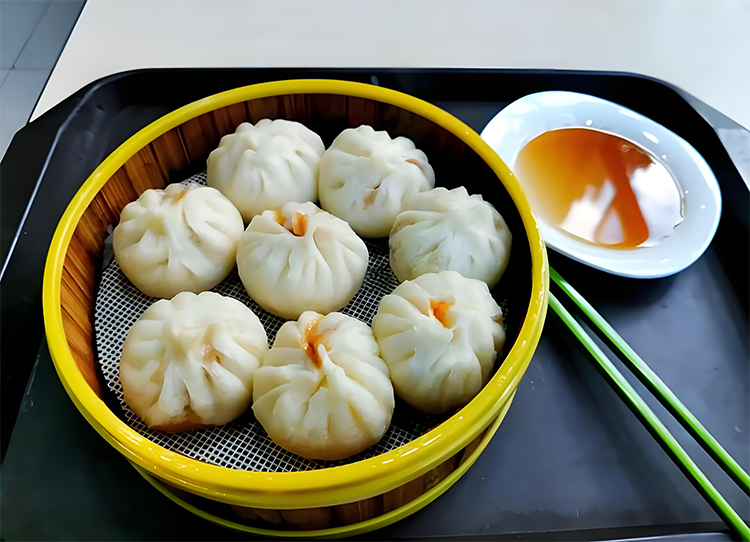Hangzhou Xiaolongbao: Jiangnan Soup Dumpling Delight
1. Hangzhou Xiaolongbao: A Bite of Southern Song Elegance
Stroll along Hangzhou’s worn bluestone streets and you’ll be guided by an irresistible aroma to steaming shops selling xiaolongbao. Hangzhou xiaolongbao is a culinary emblem of this thousand-year city: paper-thin skins, rich, savory soup, and tender fillings that have won the hearts of locals and travelers alike. More than a snack, it’s a living memory of refined Jiangnan cuisine—an elegant ritual to begin any food journey through Hangzhou.
2. Origins and Southward Migration: A Delicious Cultural Journey
The story of Hangzhou xiaolongbao is a condensed chapter of Song Dynasty culinary history. Its ancestor, the soup-filled bun, emerged in Kaifeng during the Northern Song. After the court’s exile south in 1127 and the establishment of the Southern Song capital in Lin’an (modern Hangzhou), northern foodways came with the migrants.
Local Hangzhou chefs preserved the essence of northern soup buns while adapting them to Jiangnan tastes and ingredients. They used abundant local pork and innovated by adding pigskin jelly—made from simmered collagen—as the soup base. With high-gluten flour for pliable dough and generations of refinement, the result evolved into a thinner-skinned, cleaner-tasting, more delicate bun: the distinctive Hangzhou xiaolongbao celebrated since the Southern Song.

3. Handcrafting Excellence: Culinary Art at Your Fingertips
A perfect Hangzhou xiaolongbao is the union of premium ingredients and skilled technique.
First, the stock. The soup is the soul. Chefs simmer pork skin with old hen, pork bones, ginger, and scallions for hours until collagen infuses the broth. Chilled, the stock sets into a translucent jelly that’s diced and mixed into the meat filling—this is the secret to the molten soup inside each dumpling.
Next, the dough and wrappers. High-gluten flour mixed with cool water creates a stretchy, resilient dough. Wrappers are rolled thin with a thicker center and paper-thin edges—about 8 cm in diameter—requiring expert wristwork.
Folding is critical. A single wrapper holds a spoonful of pork (usually front-leg cuts with balanced fat) and the diced jelly. Skilled hands pleat 18 or more even folds and seal a tiny “fish-mouth” at the top. The goal: a plump, evenly pleated bun whose seam holds the precious soup during steaming.
Finally, steaming. Baskets lined with pine needles or cloth carry the buns into vigorous steam. Heat melts the jelly into piping-hot soup while the thin dough cooks through. In 6–8 minutes a basket of soup-filled, translucent-skinned xiaolongbao emerges.
4. Flavor and Texture: A Symphony on the Palate
Eating Hangzhou xiaolongbao is a ritual.
Fresh from the steamer they look like delicate works of art: the almost-transparent skin reveals pink filling and jiggling broth beneath, and steam carries a pork-and-bone aroma.
Follow the local method: “lift gently, move slowly, open a window, sip the soup, then finish.” Dip lightly in a sauce of Chinkiang vinegar and shredded ginger, place the bun on a soup spoon, bite a small slit to release steam, and sip the hot broth. That first spoonful—combining (meaty aroma), dough fragrance, and tangy vinegar—is the heart of the bun.
After the soup, eat the remaining filling and wrapper together. The tender, savory meat, the chewy wrapper, and the bright vinegar balance create layered textures and flavors—like a small symphony on your tongue.

5. Cultural Meaning: Refined Everyday Life
In Hangzhou, xiaolongbao is more than fast food; it’s a cultural symbol and a lifestyle element. It embodies Jiangnan’s refined aesthetic—simple appearance concealing high craftsmanship and delicate taste. Whether a hurried commuter or a retiree enjoying morning tea, a basket of xiaolongbao often completes a local breakfast scene.
Xiaolongbao also connects people. Families and friends sharing baskets around steaming tables, exchanging news and laughter, create scenes full of everyday warmth. For visitors, trying xiaolongbao is a direct introduction to Hangzhou’s character and culinary heritage.
6. Visitor’s Tasting Guide
To make the most of your experience, here are practical tips:
- Where to go: Don’t chase only trendy spots. Many neighborhood shops and long-standing local stalls serve the most authentic xiaolongbao. Follow lines of locals—they’re usually a good sign.
- Best time: Breakfast and lunchtime for the freshest, just-steamed buns.
- How to eat: Remember “open a window, sip the soup first.” Use Chinkiang vinegar and finely shredded ginger to cut richness.
- Pairings: A basket paired with a clear soup—like duck-blood vermicelli or West Lake beef soup—makes a satisfying local meal.
- Etiquette: Handle gently to avoid breaking the skin. Enjoy quietly and naturally.

7. Try It at Home: A Simplified Hangzhou Xiaolongbao Recipe
If the taste lingers, try a home-friendly version:
Ingredients: 200 g high-gluten flour, 100 ml warm water, 250 g minced pork (30% fat), 150 g pork skin jelly (store-bought or homemade), minced ginger and scallions, light soy, cooking wine, salt, a pinch of sugar.
Method:
- Dough: Slowly add warm water to flour, knead into a smooth dough, cover and rest 30 minutes.
- Filling: Mix pork with ginger, scallions, soy, wine, salt, and sugar; beat toward one direction until sticky. Fold in diced pork skin jelly; chill.
- Assembly: Roll dough into a log, cut portions, and roll wrappers thinner at the edges. Place filling, pleat about 12–18 folds, seal.
- Steam: Place buns on parchment in a steamer; steam over boiling water for 8 minutes.
Home versions won’t fully match professional skill, but the hands-on process is a meaningful way to connect with Hangzhou’s food culture.
Hangzhou xiaolongbao bundles centuries of Song-era elegance, Jiangnan freshness, and locals’ devotion to culinary craft into one small dumpling. When you visit Hangzhou, step into a bustling old shop, order a steaming basket, and let each delicate, soup-filled bite tell you the city’s story.


